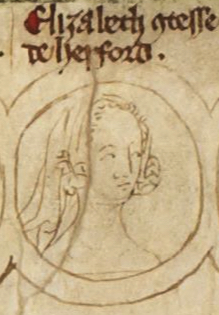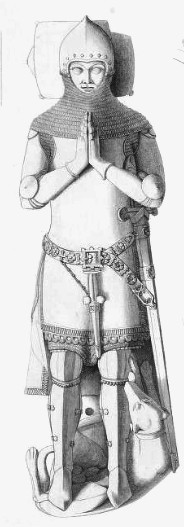by Susan Flantzer
© Unofficial Royalty 2022

A depiction of Elizabeth of Rhuddlan from the Genealogical Roll of the Kings of England; Credit – Wikipedia
Elizabeth of Rhuddlan was born on August 7, 1282, at Rhuddlan Castle in Rhuddlan, Denbighshire, Wales. The castle was built by her father King Edward I of England in 1277, following the First Welsh War. During the reign of the House of Plantagenet, their children were often identified by their place of birth, and so Elizabeth was called “of Rhuddlan”. Elizabeth was the tenth but the fifth surviving daughter and the thirteenth or fourteenth of the 14 – 16 children of Edward I, King of England and Eleanor of Castile, the first of his two wives. Mary’s paternal grandparents were Henry III, King of England and Eleanor of Provence. Her maternal grandparents were Ferdinand III, King of Castile and Toledo and King of León, and Galicia and his second wife Jeanne, Countess of Ponthieu and Aumale in her own right.

Early fourteenth-century manuscript showing Elizabeth’s parents King Edward I of England and Eleanor of Castile; Credit – Wikipedia
Elizabeth’s parents had 14 – 16 children. Only five daughters and one son survived to adulthood. The eleven siblings of Elizabeth listed below were those who were named and survived infancy for at least a couple of months.
- Katherine of England (born and died 1264), died in infancy
- Joan of England (born and died 1265), died in infancy
- John of England (1266 – 1271), died in childhood
- Henry of England (1268 – 1274), died in childhood
- Eleanor of England (1269 – 1298), married Henri III, Count of Bar, had one son and one daughter
- Joan of Acre (1272 – 1307), married (1) Gilbert de Clare, 6th Earl of Hertford, 7th Earl of Gloucester, had four children (2) Ralph de Monthermer, 1st Baron Monthermer, had four children
- Margaret of England (1275 – after 1333), married Jean II, Duke of Brabant, had one son
- Alfonso, Earl of Chester (1273 – 1284), died in childhood, heir apparent to the English throne but never became king
- Berengaria of England (1276 – 1278), died in childhood
- Mary of Woodstock (1278 – 1332), a nun at Amesbury Priory in Amesbury, Wiltshire, England
- King Edward II of England (1284 – 1327), married Isabella of France, had four children
In November 1290, when Elizabeth was eight-years-old, her mother Eleanor of Castile died. Only six of Edward I and Eleanor’s children, five daughters and one son, were still living. The only son, the future King Edward II, was the youngest child and just six years old. King Edward I had to be worried about the succession, and a second marriage with sons would ensure the succession. On September 10, 1299, 60-year-old King Edward I married 17-year-old Margaret of France, daughter of King Philippe III of France and his second wife Marie of Brabant.
Elizabeth had three half-siblings from her father’s second marriage to Margaret of France:
- Thomas of Brotherton, 1st Earl of Norfolk (1300 – 1338), married (1) Alice de Hales, had three children (2) Mary de Brewes, no children
- Edmund of Woodstock, 1st Earl of Kent (1301 – 1330), married Margaret Wake, 3rd Baroness Wake of Liddell, had four children including Joan, 4th Countess of Kent who married King Edward III‘s eldest son Edward, Prince of Wales (The Black Prince) and was the mother of King Richard II of England
- Eleanor of England (1306 – 1311), died young
In 1285, three-year-old Elizabeth was betrothed to an infant, the future John I, Count of Holland (1284 – 1299). Soon after this, the infant John was sent to England to be raised and educated at King Edward I’s court. In 1296, John’s father Floris V, Count of Holland was murdered, and John became Count of Holland.
On January 7, 1297, fourteen-year-old Elizabeth and twelve-year-old John were married at St. Peter’s Church in Ipswich, England. John I, Count of Holland was allowed to return to Holland at the end of January 1297, but Elizabeth remained in England and did not join her husband in Holland until November 1297. On November 10, 1299, childless and only fifteen years old, John I, Count of Holland died from dysentery although there were suspicions he was murdered. Now a widow, 17-year-old Elizabeth returned to England, stopping to visit her sister Margaret in the Duchy of Brabant on the way. When Elizabeth arrived in England, she first met her stepmother Margaret, who had married Elizabeth’s father King Edward I while Elizabeth was in Holland. Margaret and Elizabeth became close friends, and Elizabeth’s first child was named after her.

Effigy of Humphrey de Bohun, 4th Earl of Hereford from a memorial at Hereford Cathedral; Credit – Wikipedia
Elizabeth settled at her father’s court. She had probably met 24-year-old Humphrey de Bohun, 4th Earl of Hereford and Constable of England in the late 1280s, but they became reacquainted at court. By 1302, plans were being arranged for Elizabeth and Humphrey to marry. On November 14, 1302, Elizabeth and Humphrey were married at Westminster Abbey in London, England. After her marriage, Elizabeth continued to live at the royal court. She did not move to her husband’s estates until the death of her father King Edward I and the accession of her brother King Edward II in 1307.
Elizabeth and Humphrey had ten children
- Margaret de Bohun (1302 – 1304), died in early childhood
- Humphrey de Bohun (1303 – 1304), died in infancy
- Eleanor de Bohun (1304 – 1363), married (1) James Butler, 1st Earl of Ormond, had three children (2) Sir Thomas de Dagworth, had one daughter
- John de Bohun, 5th Earl of Hereford (1306 – 1336), married (1) Alice FitzAlan, no children (2) Margaret Basset, no children
- Humphrey de Bohun, 6th Earl of Hereford (1309 – 1361), unmarried
- Margaret de Bohun (1311 – 1391), married Hugh Courtenay, 10th Earl of Devon, had seventeen children
- William de Bohun, 1st Earl of Northampton (1312 – 1360), twin of Edward, married Elizabeth de Badlesmere, had two children
- Edward de Bohun (1312 – 1334), twin of William, married Margaret de Ros, no children; during a military campaign in Scotland, Edward tried to save a soldier who had fallen into a river, but drowned
- Eneas de Bohun, (1314 – after 1322), died in childhood
- Isabel de Bohun (born and died 1316), both Elizabeth and her daughter Isabella died shortly after birth
Humphrey was imprisoned after the English defeat by the Scots at the 1314 Battle of Bannockburn. Humphrey had fought Robert I the Bruce, King of Scots in single combat but was forced to concede. Humphrey was ransomed by his brother-in-law King Edward II. He was traded for Robert the Bruce’s second wife Elizabeth de Burgh, Queen of Scots and his daughter from his first marriage Marjorie Bruce, who had both been imprisoned by the English for eight years.
Elizabeth and especially her husband Humphrey had issues with King Edward II’s relationship with his favorite Piers Gaveston, bluntly called a traitor by Humphrey. This caused years of estrangement between Elizabeth and her brother King Edward II. They were finally reconciled in 1315, three years after Gaveston’s murder by English nobles who had had enough of him. Elizabeth spent Christmas of 1315 with her brother King Edward II and his wife Isabella of France.

Tomb of Elizabeth of Rhuddlan; Credit – www.findagrave.com
After the 1315 Christmas celebrations, Elizabeth settled at her husband’s estate in Quendon, Essex, England to await the birth of her tenth child. She gave birth on May 5, 1316, to a daughter named Isabella in honor of the Queen. Sadly, 33-year-old Elizabeth and her daughter Isabella both died the same day. Elizabeth and her daughter Isabella were interred at Waltham Abbey Church in Waltham Abbey, Essex, England.
Humphrey de Bohun, 4th Earl of Hereford survived Elizabeth by six years. He was brutally killed in battle, leading an attempt to storm a bridge, on March 16, 1322, aged 46, at the Battle of Boroughbridge during the Despenser War (1321 -1322), a revolt by nobles against King Edward II of England led by Humphrey and Roger Mortimer, 3rd Baron Mortimer of Wigmore, 1st Earl of March. Humphrey de Bohun, 4th Earl of Hereford was buried at the York Dominican Friary in North Yorkshire, England.
This article is the intellectual property of Unofficial Royalty and is NOT TO BE COPIED, EDITED, OR POSTED IN ANY FORM ON ANOTHER WEBSITE under any circumstances. It is permissible to use a link that directs to Unofficial Royalty.
Works Cited
- Elizabeth of Rhuddlan (2022) Wikipedia. Wikimedia Foundation. Available at: https://en.wikipedia.org/wiki/Elizabeth_of_Rhuddlan (Accessed: November 1, 2022).
- Елизавета Рудланская (2021) Wikipedia (Russian). Wikimedia Foundation. Available at: https://ru.wikipedia.org/wiki/%D0%95%D0%BB%D0%B8%D0%B7%D0%B0%D0%B2%D0%B5%D1%82%D0%B0_%D0%A0%D1%83%D0%B4%D0%BB%D0%B0%D0%BD%D1%81%D0%BA%D0%B0%D1%8F (Accessed: November 1, 2022).
- Flantzer, Susan, 2013. Eleanor of Castile, Queen of England. [online] Unofficial Royalty. Available at: <https://www.unofficialroyalty.com/november-28-1290-death-of-eleanor-of-castile-first-wife-of-king-edward-i-of-england/> [Accessed 1 November 2022].
- Flantzer, Susan, 2016. King Edward I of England. [online] Unofficial Royalty. Available at: <https://www.unofficialroyalty.com/king-edward-i-of-england/> [Accessed 1 November 2022].
- Humphrey de Bohun, 4th Earl of Hereford (2022) Wikipedia. Wikimedia Foundation. Available at: https://en.wikipedia.org/wiki/Humphrey_de_Bohun,_4th_Earl_of_Hereford (Accessed: November 1, 2022).
- John I, Count of Holland (2022) Wikipedia. Wikimedia Foundation. Available at: https://en.wikipedia.org/wiki/John_I,_Count_of_Holland (Accessed: November 1, 2022).
- Jones, Dan, 2012. The Plantagenets. New York: Viking.
- Williamson, David, 1996. Brewer’s British Royalty. London: Cassell.
- Wilson-Lee, Kelcey, 2019. Daughters of Chivalry: The Forgotten Princesses of King Edward Longshanks. New York: Pegasus.
